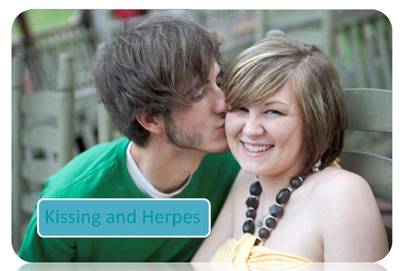Kissing is a major cause of herpes

Although many people don't know it, kissing can give you herpes, and this can be caused by either Herpes Simplex Virus type 1 (HSV-1, commonly referred to as cold sores) or Herpes Simplex Virus type 2 (HSV-2).
Over 75 % of Australians carry HSV-1 (which usually causes cold sores but also causes about 40 % of genital herpes)1 which is most commonly acquired as a child from contact with relatives, usually from kissing and about 12 % of adult Australians carry HSV-2 (the commonest cause of genital herpes) 2.
Kissing is a very common activity and herpes is a contagious infection. Only 30% of adults in Australia and New Zealand report experiencing cold sores3. This means that when a person becomes infected with the virus, they do not always have typical cold sore or herpes symptoms, and it is possible to shed the virus without any symptoms at all.
The AHMF (Australian Herpes Management Forum)'s Executive Director Tricia Berger says that while kissing demonstrates love and affection, it is also one of the main methods of transmission of herpes. "If you have a herpes sore on or near your mouth, it's likely that you'll pass the virus along to whomever you kiss. It is also possible to transmit the virus even when there are no apparent sores or symptoms, but the risk is higher when the sores are visible," she says.
This is the thrust of a new TV and radio community service awareness campaign created by the AHMF to educate people.
"No parent kissing their child or partner kissing their girlfriend wants to pass along the Herpes Simplex Virus, but people should be aware that this is the main method of transmission," says Tricia. "Once you have been infected with HSV-1 or HSV-2, the virus stays in your body for life, and can reactivate at any time".
Over 75 % of Australians carry HSV-1 (which usually causes cold sores but also causes about 40 % of genital herpes)1 which is most commonly acquired as a child from contact with relatives, usually from kissing and about 12 % of adult Australians carry HSV-2 (the commonest cause of genital herpes) 2.
Kissing is a very common activity and herpes is a contagious infection. Only 30% of adults in Australia and New Zealand report experiencing cold sores3. This means that when a person becomes infected with the virus, they do not always have typical cold sore or herpes symptoms, and it is possible to shed the virus without any symptoms at all.
The AHMF (Australian Herpes Management Forum)'s Executive Director Tricia Berger says that while kissing demonstrates love and affection, it is also one of the main methods of transmission of herpes. "If you have a herpes sore on or near your mouth, it's likely that you'll pass the virus along to whomever you kiss. It is also possible to transmit the virus even when there are no apparent sores or symptoms, but the risk is higher when the sores are visible," she says.
This is the thrust of a new TV and radio community service awareness campaign created by the AHMF to educate people.
"No parent kissing their child or partner kissing their girlfriend wants to pass along the Herpes Simplex Virus, but people should be aware that this is the main method of transmission," says Tricia. "Once you have been infected with HSV-1 or HSV-2, the virus stays in your body for life, and can reactivate at any time".
MORE





